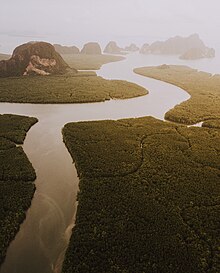Ao Phang Nga National Park
| Ao Phang Nga National Park | |
|---|---|
 Ao Phang Nga National Park | |
 | |
| Location | Phang Nga Province, Thailand |
| Nearest city | Phang Nga |
| Coordinates | 8°21′0″N 98°29′0″E / 8.35000°N 98.48333°ECoordinates: 8°21′0″N 98°29′0″E / 8.35000°N 98.48333°E |
| Area | 400 km2 (150 sq mi) |
| Established | 29 April 1981 |
| Visitors | 999,035 (in 2019) |
| Governing body | Department of National Park, Wildlife and Plant Conservation (DNP) |
| Official name | Phang Nga Bay Marine National Park |
| Designated | 14 August 2002 |
| Reference no. | 1185[1] |
Ao Phang Nga National Park (Thai: อุทยานแห่งชาติอ่าวพังงา) is in Phang Nga Province in southern Thailand. It includes coastal sections of Mueang Phang Nga District and Takua Thung District.[2] Most of the park consists of an area of the Strait of Malacca studded with numerous limestone tower karst islands.[3] The best known of these islands is Khao Phing Kan, popularly called "James Bond Island" because it was used as a location for the James Bond movie The Man with the Golden Gun.
The dramatic appearance of the islands with their sheer sides has made the area a popular tourist attraction.[4] The park also protects the largest area of native mangrove forest remaining in Thailand.[2]

History[]
The park was created by royal decree and announced in the Royal Gazette under proclamation number 98, section 64, 29 April 1981.
Environment[]
The effects of mass tourism on the park prompted Fodor's Travel to place the park on their "No List" for 2018, suggesting that tourists skip the park in order to allow it to recuperate from being loved to death.[5]
Geology[]
According to its structure and geomorphology, it is a mountain range that originated approximately between the Cretaceous and the early Tertiary period, approximately 136-36 million years ago. It is also the result of a structural feature known as fault. "Khlong Marui fault" and "Phang Nga fault." There are also sedimentary rock and metamorphic mountains interspersed in line, especially in the limestone mountains. As a result of this change in the natural environment, many holes or caves are formed.
Prehistoric evidence of human habitation was discovered in 1987 at Khao Tao in Phang Nga Bay National Park by a discovery of human burial grounds. By study fossils of shells in caves and rocks on islands in Phang Nga bay, it was found that during the Pleistocene and early Holocene epochs, about 11,000 years ago, sea levels dropped significantly during the Ice Age. The rocky mountains that are islands as seen today are mostly on the upland. Around 7,500-8,500 years ago, the sea level gradually rose to around 4.5 meters above current sea level. Around 4,000-5,000 years ago, sea levels interchangeably rose and fell. Around 2,700-3,700 years ago, sea level was relatively stable but were 1.5 and 2.5 meters higher than the present. Around 1,500 years ago, the sea level was 1.5 meters higher than the present.
Flora and Fauna[]
Within Ao Phang-nga contains one of the largest and best-preserved mangrove forests in Thailand.[6]
The forest has important functions in the coastal ecosystem, such as a natural storm barrier and a breeding ground for marine living animals.
Common plant species in the mangrove forest are Rhizophora apiculata, Rhizophora mucronata, Avicennia alba, Avicennia officinalis, Bruguiera cylindrica, Bruguiera parviflora, and the cannonball trees Xylocarpus granatum and Xylocarpus moluccensis. Inside the islands, tropical rainforest grows with species such as Hopea ferrea, the pea plant Parkia timoriana, and Acacia catechu, the mulberry tree Artocarpus lacucha, the Clusia tree Garcinia cowa and Morinda coreia, and on more calcareous soil Colocasia gigantea, , and .
An inventory in 1991 resulted in 206 animal species, divided into 17 mammal species, 88 bird species, 18 reptile species, 3 amphibians, 24 fish species and 45 other marine animals.
The lar gibbon and serow has previously been found in the area, but now become extinct in the region.
Endangered mammal species within the national park are smooth-coated otter, leaf monkeys, and smoky leaf monkeys and the crab-eating macaque.[6]
The brahminy kite, pacific reef heron, white-bellied sea eagle, many species of kingfishers, asian dowitcher, and edible-nest swiftlet are species of birds that could be found here.[6]
Among reptiles and amphibians, mangroves snakes, rhacophoridae, and saltwater frogs can be found here.[6]
References[]
- ^ "Phang Nga Bay Marine National Park". Ramsar Sites Information Service. Retrieved 25 April 2018.
- ^ a b "Ao Phang-nga National Park". National Park website. Archived from the original on 20 October 2014. Retrieved 24 November 2014.
- ^ "Thailand: Ko Khao Phing Kan (James Bond Island), Ao Phang Nga (Phangnga Bay) National Park, Phang Nga Province". Pictures from History. Retrieved 24 November 2014.
- ^ "Tourism Statistic". Archived from the original on 2013-01-16. Retrieved 2012-08-13.
- ^ "Fodor's No List 2018". Fodor's Travel. 2017-11-15. Retrieved 31 December 2017.
- ^ a b c d National Parks in Thailand (PDF). dnp.go.th. 2006. ISBN 9742860874. Archived from the original (PDF) on 2013-05-23. Retrieved 2021-02-17.
External links[]
| Wikimedia Commons has media related to Ao Phang Nga National Park. |
 Ao Phang Nga National Park travel guide from Wikivoyage
Ao Phang Nga National Park travel guide from Wikivoyage
- IUCN Category II
- National parks of Thailand
- Protected areas established in 1981
- Geography of Phang Nga province
- Tourist attractions in Phang Nga province
- 1981 establishments in Thailand
- ASEAN heritage parks
- Marine protected areas of Thailand
- Southern Thailand geography stubs
